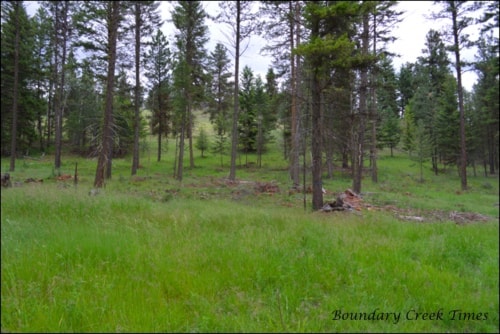The results of an ecosystem restoration project in the West Boundary are easily visible from the Hwy 3 near Johnstone Creek Provincial Park just west of Rock Creek.
It is there, on the north side of the highway between Johnston Creek Road East and Conkle Lake Road, that a Ministry of Forests, Lands and Natural Resource Operations (MFLNRO) ecosystem restoration project has been ongoing since last winter.
According to habitat biologist Lisa Tedesco the Johnstone Creek site is one of seven ecosystem restoration sites in the Boundary. There are two other local projects in the Rock Creek/Midway area, she explained - the ministry completed a project at Bubar Creek over the winter and will be undertaking another in the Ingram Creek drainage this winter.
Local resident Fred Marshall served as RPF and site coordinator for the Johnstone Creek project. He explained that over time, mainly because of our diligence in putting fires out, the grasslands and semi-open grasslands and semi-closed forest in the area had accumulated an inordinate number of trees. “It wasn’t really natural anymore,” said Marshall.
Phase one last winter saw Bill and Ryan Bosovich selectively log the site for merchantable timber – selecting smaller trees, the ones of poorer quality, and thereby reducing the stocking density.
The next phase of the contract was completed in the spring and used three different treatment options: To create a more open to semi open forest, undersized trees that weren’t merchantable were spaced and the slash was bucked and piled for burning.
In selected areas the slash was left on the ground as course woody debris.
The third option was to just pull the slash back from the base of some of the trees in preparation for broadcast burning that will be done over the next two spring seasons.
Tedesco said the community and other stakeholders would be consulted prior to the prescribed burns.
Marshall identified many benefits flowing from the project – economic activity for the loggers, which enhanced work both for them and the workers at the mill with related spin-offs for the community, increased wildlife habitat and biodiversity, and much reduced fire hazard.
Tedesco said the Habitat Conservation Trust Foundation (HCTF) funded the majority of the work with support from the MFLNRO Land Based Investment Strategy Fund. She explained that portions of BC hunting and fishing license fees are dedicated to conservation projects; this money is managed by the HCTF to directly enhance opportunities to use and enjoy wildlife and fish resources.
The treatments at Johnstone Creek cost $172,000, roughly $2,000/ha, which she says is in line with the averages coming out of the East Kootenay trench restoration programs.
This area is within the range grazed by the nearby Fossen Ranch and alternate spring pasture has been found for them, which will be utilized this year, and following the prescribed burning. Tedesco said this rest rotation on the pasture allows the vegetation to begin recovery with reduced grazing pressure.
“I hope people will see the importance and value of restoration work as a good land management tool that will help keep our ecosystems and habitats healthy and resilient now and into the future,” said Tedesco.
While there is no formal long-term prescription prepared at this time, the site will be monitored for at least 10 years. “What we learn from this monitoring will help us decide how to proceed in the future,” she said.
